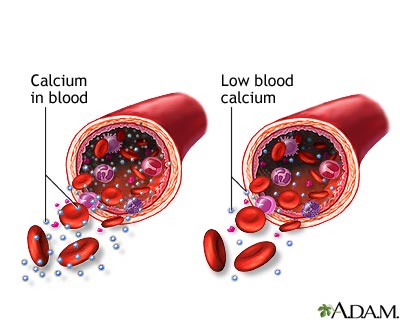Health Library
Low calcium level - infants
Hypocalcemia - infants
Calcium is a mineral in the body. It is needed for strong bones and teeth. Calcium also helps the heart, nerves, muscles, and other body systems work well.
A low blood calcium level is called hypocalcemia. This article discusses low blood calcium level in infants. Hypocalcemia can occur at any age.
Images

I Would Like to Learn About:
Causes
A healthy baby most often has very careful control of the blood calcium level by normal bodily systems.
A low calcium level in the blood is more likely to occur in newborns, more commonly in those who were born too early (preemies). Common causes of hypocalcemia in a newborn include:
- Certain medicines
- Diabetes in the birth mother
- Episodes of very low oxygen levels
- Infection
- Stress caused by serious illness
There are also some rare illnesses that can lead to low blood calcium level. These include:
- DiGeorge syndrome, a genetic disorder.
- The parathyroid glands help control calcium use and removal by the body. Rarely, a child is born with underactive parathyroid glands.
Symptoms
Babies with hypocalcemia often have no symptoms. Sometimes, babies with low blood calcium levels are jittery or have tremors or twitching. Rarely, they have seizures.
These babies may also have a slow heart rate and low blood pressure.
Exams and Tests
The diagnosis is most often made when a blood test shows that the infant's blood calcium level is low.
Treatment
The baby may get extra calcium, if needed.
Outlook (Prognosis)
Problems with a low blood calcium level in newborns or premature infants most often do not continue for a long term.
Related Information
Premature infantReferences
Doyle DA. Hormones and peptides of calcium homeostasis and bone metabolism. In: Kliegman RM, St. Geme JW, Blum NJ, Shah SS, Tasker RC, Wilson KM, eds. Nelson Textbook of Pediatrics. 21st ed. Philadelphia, PA: Elsevier; 2020:chap 588.
Escobar O, Gurtunca N, Viswanathan P, Witchel SF. Pediatric endocrinology. In: Zitelli BJ, McIntire SC, Nowalk AJ, Garrison J, eds. Zitelli and Davis' Atlas of Pediatric Physical Diagnosis. 8th ed. Philadelphia, PA: Elsevier; 2023:chap 9.
BACK TO TOPReview Date: 11/6/2023
Reviewed By: Neil K. Kaneshiro, MD, MHA, Clinical Professor of Pediatrics, University of Washington School of Medicine, Seattle, WA. Also reviewed by David C. Dugdale, MD, Medical Director, Brenda Conaway, Editorial Director, and the A.D.A.M. Editorial team.
 | A.D.A.M., Inc. is accredited by URAC, for Health Content Provider (www.urac.org). URAC's accreditation program is an independent audit to verify that A.D.A.M. follows rigorous standards of quality and accountability. A.D.A.M. is among the first to achieve this important distinction for online health information and services. Learn more about A.D.A.M.'s editorial policy, editorial process and privacy policy. A.D.A.M. is also a founding member of Hi-Ethics. This site complies with the HONcode standard for trustworthy health information: verify here. |
The information provided herein should not be used during any medical emergency or for the diagnosis or treatment of any medical condition. A licensed medical professional should be consulted for diagnosis and treatment of any and all medical conditions. Links to other sites are provided for information only -- they do not constitute endorsements of those other sites. No warranty of any kind, either expressed or implied, is made as to the accuracy, reliability, timeliness, or correctness of any translations made by a third-party service of the information provided herein into any other language. © 1997- 2024 A.D.A.M., a business unit of Ebix, Inc. Any duplication or distribution of the information contained herein is strictly prohibited.
